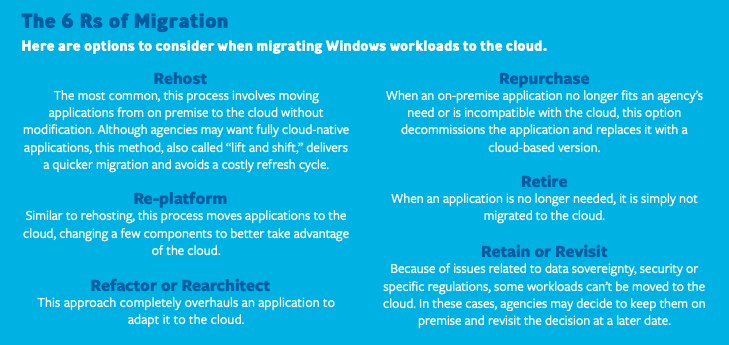As state and local agencies look for ways to improve performance, optimize costs and embrace a digital future, they are turning to the cloud for many of their applications, databases, infrastructure and services. Yet many are hesitant to do so with Windows workloads, which tend to remain on premise. As a result, agencies miss out on many of the availability, cost, performance and scalability benefits that cloud provides.
In some cases, agencies are holding back because of concerns about complexity, security, and maintaining performance, reliability and availability. Sometimes they are concerned about changes in user access and application development.
Often, agencies don’t believe it’s even possible to run Windows workloads in the cloud. And if they do think it’s a possibility, they might have the misconception that Windows workloads will work only in Microsoft’s Azure cloud. Other concerns include:
- The portability of Microsoft licensing
- The expense involved in porting workloads
- Navigating multiyear enterprise agreements
As a result, many agencies simply keep their Windows workloads on premises — and forfeit the opportunity to take advantage of the efficiency and elasticity of a cloud platform, which can lead to better license utilization and lower infrastructure costs. It can also create long-term commitments that don’t align with the agency’s best interests and modernization plans.
Solution: Windows Workloads in the Cloud
The truth is that it’s not only possible to move Windows workloads to the cloud, but it’s a path toward freedom of choice, lower costs and release from vendor lock-in. Once ported to the cloud, the benefits start to accrue rapidly.
A primary benefit is cost, but there are many others, too. For example, cloud platforms typically have tools to improve access to Windows services, such as Amazon’s FSx for Windows File Server, a fully managed, native Windows file system that provides shared file storage, or AWS Managed Microsoft Active Directory (AD), which doesn’t require agencies to synchronize or replicate data from an existing AD to the cloud.
Reliability also becomes a nonissue. For example, organizations running Windows on AWS averaged a 442% ROI over five years, experienced 98% less unplanned downtime and achieved a 56% lower five-year cost of operations, according to IDC.
More agencies are realizing the potential, and are at least considering the move. Top goals include:
- Improving the performance and reliability of the SQL infrastructure
- Mitigating the impact of Microsoft end-of-support on Windows and SQL Server 2008
- Speeding application development and allowing developers to tap into containers and serverless technology
- Improving security and compliance
- Optimizing total cost of ownership (TCO) for all Microsoft workloads, including AD, Dynamics, Exchange, .Net apps, SharePoint, SQL Server and Windows Server

This article is an excerpt from GovLoop’s recent report, “Migrating Windows Workloads to the Cloud.” Download the full report here.







Leave a Reply
You must be logged in to post a comment.